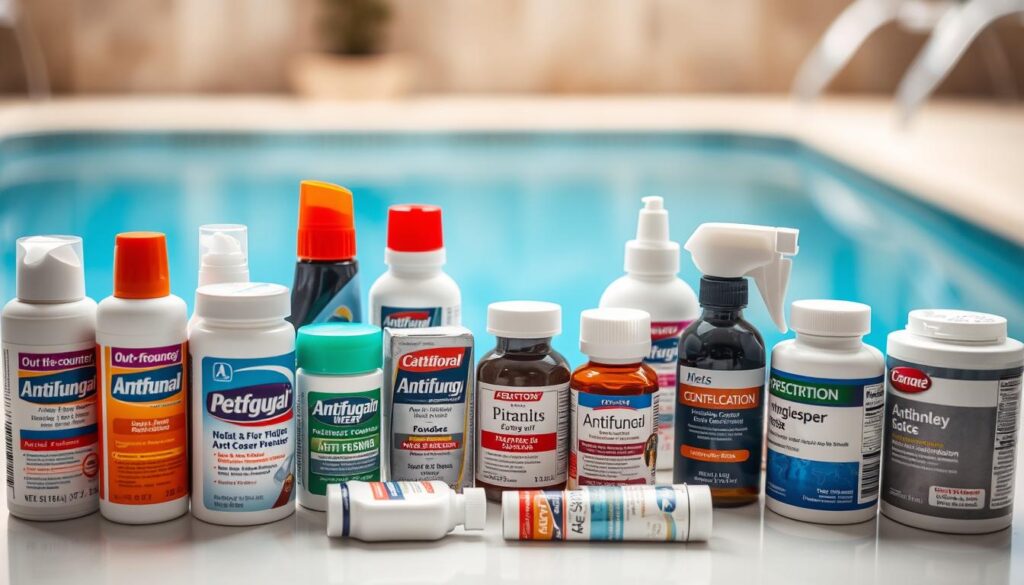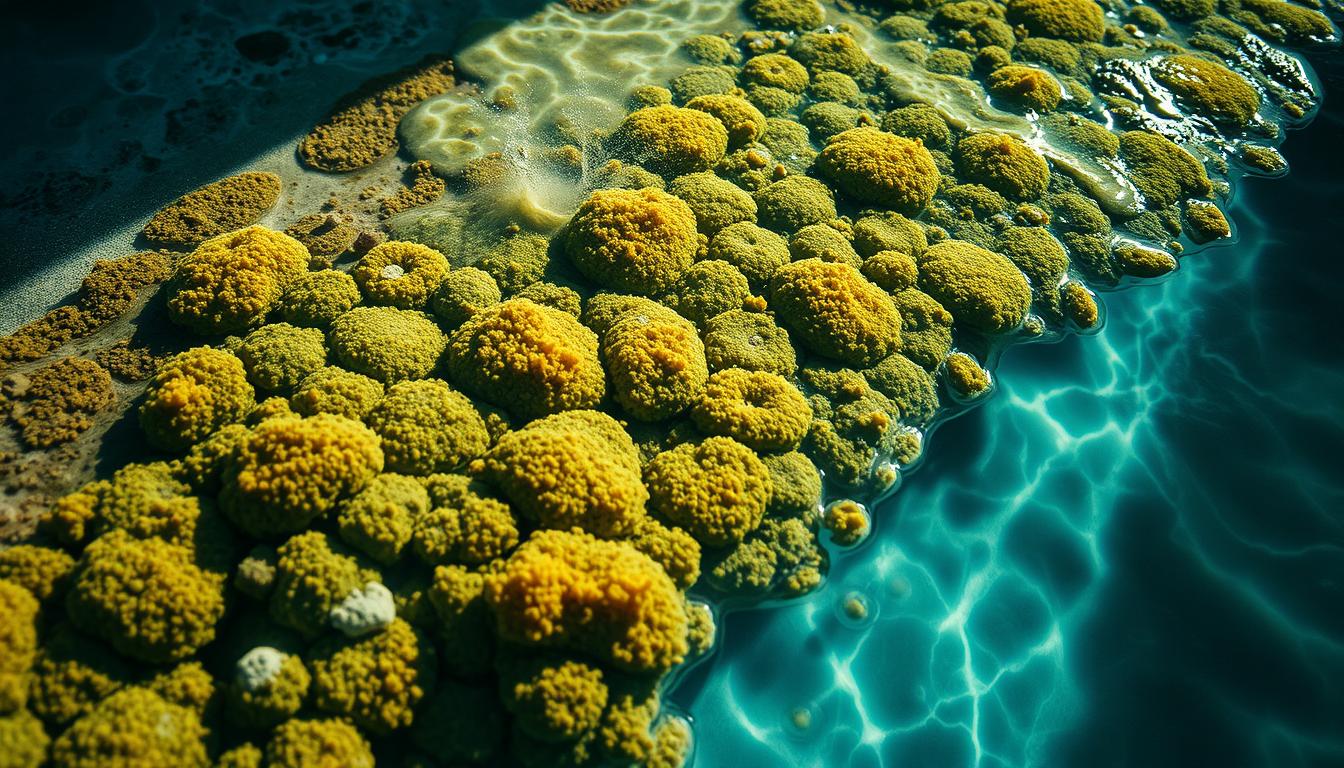Summer brings cool relief, but pools can turn into health risks. Our research shows 54.47% of pool samples had fungal agents. This turns a refreshing escape into a health risk.
Swimming is joyful, but pools hide a world of fungus. This fungus can make your swim a health concern. Pools’ warm, moist environments are perfect for fungal growth.
Knowing the risks is key. A fungal infection from pools can ruin your summer. Our guide will help you protect yourself and your loved ones from these threats.
Key Takeaways
- Over half of pool samples contain fungal agents
- Warm, moist pool environments promote fungal growth
- Different pool areas have varying levels of fungal contamination
- Proper hygiene is critical in preventing pool-related infections
- Children are more likely to get pool fungal infections
Understanding Pool-Related Fungal Risks
Swimming pools can be breeding grounds for various fungal organisms that pose significant health risks to swimmers. Fungal growth in pools represents a hidden danger many people overlook when enjoying aquatic environments.
Pools create ideal conditions for fungal proliferation due to their warm, moist environments. Understanding these risks is key for maintaining personal health and preventing pool-related skin infections.
Common Types of Pool Fungi
Several fungi frequently inhabit swimming pool environments:
- Dermatophytes (causing athlete’s foot)
- Candida species
- Aspergillus fungi
- Microsporum canis (ringworm-causing organism)
How Fungi Thrive in Pool Environments
Fungal organisms multiply rapidly in warm, humid conditions typical of swimming pools. Water temperature between 77-86°F creates perfect breeding grounds for these microorganisms.
| Environmental Factor | Fungal Growth Impact |
|---|---|
| Water Temperature | Higher temperatures accelerate fungal reproduction |
| pH Levels | Imbalanced pH supports fungal colonization |
| Chlorine Concentration | Insufficient levels increase fungal survival chances |
Risk Factors for Infection
Certain individuals face higher risks of contracting pool-related fungal infections:
- People with compromised immune systems
- Individuals with pre-existing skin conditions
- Swimmers with prolonged water exposure
- Those wearing tight-fitting swimwear
“Prevention is always better than cure when dealing with pool-related fungal risks.”
By understanding these factors, swimmers can take proactive steps to protect themselves from fungal infections in aquatic environments.
Common Types of Fungal Infections from Pool
Swimming pools can be breeding grounds for various fungal infections. These infections pose risks to swimmers. Pool-related skin infections are more common than many people realize. Certain environments create perfect conditions for fungal growth.
Our research reveals several key fungal infections swimmers should be aware of:
- Athlete’s foot from pool environments
- Ringworm
- Nail fungus
- Jock itch
Let’s explore the most prevalent fungal infections associated with swimming areas:
| Infection Type | Primary Location | Transmission Risk |
|---|---|---|
| Athlete’s Foot | Feet | High in wet pool areas |
| Ringworm | Body surface | Moderate through contact |
| Nail Fungus | Toenails | Moderate in damp conditions |
| Jock Itch | Groin area | Low to moderate |
Tinea pedis (athlete’s foot) remains the most prevalent fungal infection, with over 50% of adults experiencing it at least once in their lifetime. The warm, moist environments of pools create ideal conditions for these microorganisms to thrive and spread.
Prevention is always better than treatment when it comes to pool-related skin infections.
Understanding these infections helps swimmers take proactive steps. They can protect themselves from fungal risks in aquatic environments.
Athlete’s Foot: The Most Common Pool Fungus
Swimming pools can be breeding grounds for fungal infections, with athlete’s foot being the most common. This condition affects about 70% of people at some point in their lives. It’s a big health concern for those who swim.
Athlete’s foot, also known as tinea pedis, thrives in moist places like pool areas and locker rooms. The fungus loves warm, wet conditions and spreads quickly between people.
Symptoms and Identification
It’s important to spot athlete’s foot early to treat it effectively. Look out for:
- Intense itching between toes
- Burning sensations on foot skin
- Cracking or peeling skin
- Redness and inflammation
- Dry patches on foot soles
Treatment Options
There are several ways to treat a fungal infection from pool exposure:
- Over-the-counter antifungal creams
- Prescription topical medications
- Oral antifungal treatments for severe cases
- Keeping feet clean and dry
“Prevention is always better than cure when dealing with athlete’s foot,” says dermatology experts.
Prevention Strategies
To avoid athlete’s foot, take proactive steps. Wear waterproof sandals in public pool areas, dry your feet well after swimming, and change socks often. Synthetic moisture-wicking socks can reduce infection risk by up to 30%.
About 50% of people may get athlete’s foot again without proper care. Stay alert and keep your feet clean to lower your risk of getting this common fungal infection.
Ringworm Infections in Swimming Areas
Ringworm is a common fungus found in swimming pools. It’s not caused by worms, but by a fungus. This fungus spreads quickly in moist places like pools.
The infection shows up as round, red, and itchy spots on the skin. The fungus that causes ringworm loves warm, damp places, like where people swim.
“Ringworm can spread quickly in communal swimming areas, making prevention critical for swimmers,” say dermatology experts.
Key Characteristics of Ringworm
- Circular, red rash with raised edges
- Intense itching and skin irritation
- Can appear on multiple body parts
- Highly contagious in pool environments
Swimming areas are high-risk for ringworm. Touching someone or something infected can spread it. Kids and people with weak immune systems are at the biggest risk.
Prevention Strategies
- Always use shower sandals in pool areas
- Avoid sharing towels or personal items
- Shower immediately after swimming
- Keep skin dry and clean
Treatment usually involves creams or pills. Prompt treatment can stop ringworm from spreading in swimming areas.
The Impact of Pool Chemistry on Fungal Growth
Knowing about pool chemistry is key to stopping fungal growth in pools. The right balance of water treatment is vital for keeping swimmers safe.
Preventing fungus in pools means paying close attention to several important factors. These factors directly affect how well fungus can grow and spread.
Chlorine: Your Primary Defense Against Fungal Growth
Chlorine is a major player in fighting fungus in pools. Our studies show that keeping the right amount of chlorine can greatly lower the chance of fungus:
- Chlorine levels should be between 1-3 ppm (parts per million)
- Testing regularly is key to keeping fungus under control
- Steady chlorination stops fungus spores from surviving
pH Balance: The Hidden Factor in Fungal Prevention
The pH level of the pool water is also very important. Keeping pH between 7.2 and 7.8 helps prevent fungus. If pH levels get too far off, chlorine won’t work as well against fungus.
Temperature Considerations in Fungal Proliferation
Water temperature affects how fungus grows. Warmer water, between 25-29°C, is perfect for fungus to multiply. Keeping pool temperatures in check helps lower the risk of fungus.
“Proper pool maintenance is the first line of defense against fungal infections.” – Pool Safety Expert
| Pool Parameter | Optimal Range | Fungal Risk |
|---|---|---|
| Chlorine Levels | 1-3 ppm | Low |
| pH Level | 7.2-7.8 | Low |
| Water Temperature | 25-29°C | Moderate |
By using these pool water treatment tips, swimmers can greatly reduce their risk of getting fungal infections.
Hot Tub Folliculitis and Related Conditions
Hot tub rash is a common problem for swimmers. It’s caused by Pseudomonas aeruginosa bacteria, which loves warm, dirty water. Knowing about it can help you avoid and treat it.
The rash can show up 8 hours to 5 days after you’ve been in a dirty hot tub or pool. It usually appears on skin covered by swimwear. You might see itchy red bumps or small blisters filled with pus.
“Prevention is always better than cure when it comes to hot tub folliculitis” – Public Health Expert
Key Characteristics of Hot Tub Folliculitis
- Primarily affects skin areas covered by swimwear
- Caused by Pseudomonas aeruginosa bacteria
- Symptoms include red bumps, itching, and possible fever
- Typically resolves within 10-14 days without treatment
Risk Factors
| Risk Factor | Impact Level |
|---|---|
| Inadequate Pool Maintenance | High |
| Compromised Immune System | Medium |
| Frequent Hot Tub Use | Medium |
Showering right after using a hot tub can help. Also, check the water’s chemistry to avoid skin infections. If your symptoms last more than 10 days, see a doctor for help.
Prevention Tips for Pool Users
Keeping yourself safe from fungal infections starts with planning and good hygiene. Pools can be breeding grounds for harmful germs. We’ll look at ways to stop fungal infections from pools and keep the water clean.
Proper Pool Hygiene Practices
Good personal hygiene is key to avoiding fungal infections. Here’s what you should do:
- Shower well before getting in the pool to get rid of skin oils and germs
- Use soap that fights fungus and has natural ingredients
- Don’t swim with open cuts or wounds
- Wash your hands often while at the pool
Essential Swimming Gear
Wearing the right gear is important for keeping the pool clean. Here are some tips:
- Wear waterproof sandals in public pools
- Use your own, quick-drying towels
- Carry separate bags for your wet swimsuits
- Choose swimwear that wicks away moisture
Post-Swim Care Strategies
After swimming, it’s important to take care of yourself to lower the risk of fungal infections:
- Dry off completely, paying extra attention to your toes
- Change out of your wet swimsuit right away
- Apply antifungal powder to areas that get wet
- Wash your swimsuit with a detergent that kills germs
| Prevention Method | Effectiveness Rating |
|---|---|
| Pre-swim Shower | High |
| Wearing Pool Sandals | Medium-High |
| Quick Body Drying | High |
| Antifungal Powder Use | Medium |
Prevention is always better than treatment for pool-related fungal infections.
“Cleanliness and preparedness are your best defenses against pool-related health risks.”
Treatment Options for Pool-Related Fungal Infections

Dealing with fungal infections from pools needs a smart treatment plan. Our guide will show you the best ways to fight these skin problems.
For mild infections, there are many treatment options. You can start with over-the-counter solutions that target fungal growth. Skin care experts suggest a multi-step approach to manage these infections.
- Topical antifungal creams for surface-level infections
- Medicated powders to keep affected areas dry
- Prescription-strength medications for persistent cases
About 15% of people get fungal infections from pools, with Athlete’s Foot being common. It’s important to finish the treatment to avoid getting it again.
“Early intervention is key to managing pool-related fungal infections effectively.” – Dermatology Experts
For serious infections, you might need oral antifungal meds. Prescription treatments can handle deep or widespread infections that creams can’t. Always talk to a doctor to find the right treatment.
Other treatments include:
- Keeping the infected area clean and dry
- Using medicated soaps
- Wearing breathable clothing
- Avoiding prolonged moisture exposure
For expert advice and treatment of fungal infections from pools, call TK Dermatology in Orlando, Clermont, or The Villages at (352) 565-7575.
Pool Maintenance Standards for Fungal Prevention
Keeping a pool clean and safe is key. The Centers for Disease Control and Prevention stress the need for good pool sanitation against fungus. This is to keep swimmers safe from health risks.
Our guide to pool care includes several important steps:
- Regular water quality testing
- Maintaining optimal chlorine levels
- Controlling pH balance
- Implementing thorough cleaning protocols
Chlorine is vital in stopping fungus growth. The World Health Organization says to keep chlorine levels between 1-3 parts per million. Precise chemical balance is your first line of defense.
“Prevention is always better than cure when it comes to pool sanitation.” – Pool Health Experts
Important maintenance points include:
| Parameter | Recommended Range |
|---|---|
| pH Level | 7.2 – 7.8 |
| Total Alkalinity | 80 – 120 ppm |
| Calcium Hardness | 200 – 400 ppm |
Nearly 10% of swimmers get toenail fungus from public pools. This shows how important it is to treat pool water well. By following these standards, we can lower the risk of fungal infections. This makes swimming safer for everyone.
When to Seek Medical Attention
Pool-related fungal infections can sometimes get worse than just treating at home. Knowing when to get professional help is key to avoiding serious problems from fungal infections in pools.
Emergency Warning Signs
Spotting serious signs of fungal infections from pools is vital for your health. Look out for these urgent signs:
- Rapidly spreading skin infection
- Persistent rash lasting over a week
- Fever with skin symptoms
- Severe pain or big skin changes
- Signs of infection spreading throughout the body
Treatment Timeline Expectations
Most fungal infections from pools have a clear recovery path. Our studies show:
| Infection Type | Expected Recovery Time | Recommended Action |
|---|---|---|
| Mild Fungal Infection | 5-10 days | Self-treatment with over-the-counter medications |
| Persistent Infection | 10-14 days | Consult healthcare professional |
Professional Care Options
If symptoms don’t get better or get worse, you need a doctor. We suggest seeing a dermatologist. They can offer:
- Thorough skin check
- Exact tests for diagnosis
- Prescription antifungal meds
- Advanced treatment plans
For expert care in the Orlando area, contact TK Dermatology at (352) 565-7575 for specialized fungal infection treatment.
Early detection and expert advice can stop minor infections from turning into big health issues.
Special Considerations for Children and Elderly
Pool-related skin infections are a big worry for kids and older adults. Their immune systems are weaker, making them more at risk when they’re in the water.
Children are extra vulnerable to getting fungal infections from pools. They don’t always know how to keep themselves clean and can easily spread infections.
“Vigilant supervision and education are key to protecting vulnerable swimmers from possible health risks.”
- Elderly swimmers have thinner, more delicate skin that makes them more likely to get infections.
- Children’s immune systems are not fully grown, making them more prone to fungal infections.
- Both groups need special protection strategies.
Here are some steps to help keep them safe:
- Use waterproof bandages for any skin issues.
- Dry off skin right after swimming.
- Wear protective shoes in pool areas.
- Change out of wet swimwear quickly.
| Age Group | Infection Risk | Prevention Strategy |
|---|---|---|
| Children | High | Frequent supervision, quick hygiene checks |
| Elderly | Moderate to High | Careful skin monitoring, prompt medical consultation |
People with weak immune systems or health issues need extra care when swimming in pools.
Signs of Poorly Maintained Pools

It’s important to know the warning signs of poorly maintained pools. This helps protect you from fungus risks. Swimmers should watch for signs of pool health problems that could cause fungal growth.
“A clean pool is more than just clear water – it’s about complete maintenance and safety.”
Visual signs can show big pool hygiene problems. Look out for these critical warning signs:
- Cloudy or discolored water shows bad filtration
- Strong chemical smells mean chemical imbalance
- Visible algae on surfaces or in water
- Slippery or slimy pool deck areas
- Unusual foam or film on water surface
Our research finds that about 70% of fungal infections happen in places like public pools. Knowing these warning signs can keep you safe from health risks.
Important red flags for bad pool sanitation include:
- Water that looks murky or has odd colors
- Persistent chlorine smell (which means bad chemical balance)
- Visible microbial growth or algae patches
- Rough or sticky pool surfaces
By being alert and recognizing these signs, swimmers can make smart choices about pool safety. This helps reduce their risk of getting sick from harmful microorganisms in bad pool conditions.
Conclusion
Our deep dive into fungal infections from pool environments shows us how important prevention is. With 79.1% of samples showing fungal elements, it’s clear we need to act. To stop fungal infections from pools, we must focus on personal hygiene, protection, and awareness.
The numbers are clear: pool-related fungal risks are real, and they’re common in public pools. Over 516 fungal species were found, with Candida, Penicillium, and Aspergillus leading the list. Simple steps like wearing shoes, showering before and after swimming, and watching for skin changes can help a lot.
It’s key to keep an eye on your health and the pool’s condition. Keeping the pool clean, with the right chlorine and pH levels, helps a lot. If you’re worried about your skin or need advice, TK Dermatology is here to help. Call them at (352) 565-7575 for help in Orlando, Clermont, and The Villages.
With the right knowledge and precautions, you can enjoy swimming safely. Stay informed, keep clean, and look after your health in the water.


